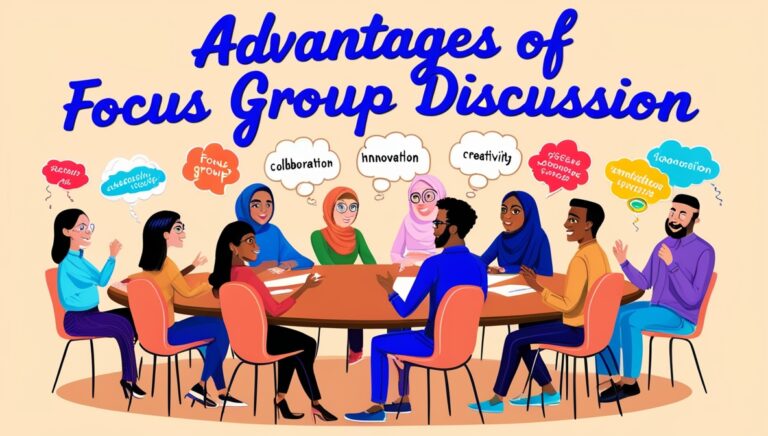Focus Group Discussion (FGD)
“Focus Group Discussions (FGD) are a qualitative approach to gain an in-depth understanding of social issues from a group of people.” The method focuses on gathering data from a specific group of persons rather than from a statistically representative sample of a more diverse population.
Focus groups offer a high degree of flexibility and adaptability, allowing researchers to tailor the discussion to address specific research objectives or adapt to emerging themes and ideas. The open-ended nature of focus group discussions enables researchers to explore unanticipated topics. Focus groups also encourage better group discussions and increase interaction. It is purely a qualitative approach for data collection.
A group of people who have sufficient knowledge or information is approached, and the researcher makes decisions on the selected issues and phenomenon. Sometimes, the researcher paid some amount to a trained moderator. For this purpose, locations must be secured, and the researcher should show great reverence to the participants as they are usually well-informed or highly qualified in the relevant field. Talk shows on TV are the best examples of FGD.
Types of Groups in FGD
Natural Groups
The study involved multiple participants in an existing formal or informal group, such as family members, colleagues, elderly persons, working women, or neighbors. Conducting a focus group discussion with a natural group can provide valuable insights into the discrepancies and similarities between people’s words and actions, as well as the reactions and comments of other participants.
Expert Groups
It is made up of individuals who possess extensive expertise and experience in the research field. These groups, such as nurses from health district centers, drugstore vendors, or ambulance drivers, are usually smaller than typical focus group discussions. They are designed to gather a significant amount of highly specific information, although the statements from participants may differ.

Advantages of FGD
Provision of a Diverse Set of Responses
Focus groups offer a valuable method for assessing respondents’ reactions to new ideas. Participants can offer immediate suggestions that may enhance the ideas being presented through this platform. This method also assists in identifying issues and finding ways to make improvements, which means researchers can gain valuable insight into current social problems.
Confirm Insights Obtained from Other Methodologies
Qualitative research methods have the potential to generate a substantial amount of data regarding a particular concept. For some investigators, the information may come across as impersonal or lacking authenticity, which can be a concern. If the results from previous attempts appear unreliable, a focus group can either validate or negate the insights that researchers gathered using other methods.
After the responses are organized following a focus group session, researchers can proceed with their exploration of a concept or make the required modifications to address the key points raised during the discussion.
Cost-effective Way to Get Information
Online focus groups have become increasingly popular due to the availability of web conferencing software. This advantage allows researchers to expand their sample size, engage in more conversations, and assess important factors without facing the limitations imposed by other qualitative methods.
Provide time-saving Opportunities
A focus group offers an organized format that simplifies the process of gathering a large number of opinions or feedback. The design enables moderators to address various aspects of a concept efficiently, avoiding the need for repetitive individual interviews to gather information.
Enhance Knowledge of Group Members
Focus groups offer a distinct approach to gathering information as each person’s responses often complement and expand upon one another. Every individual has the opportunity to share their perspective or opinion, and the collective experiences of others in the room can help to broaden or challenge the initial idea presented. It enables individuals to explore alternative perspectives they may not have considered on their own.
Provides Anonymity for many of the Participants
When individuals join a focus group, they provide their personal information, including their names. However, participants are assured a certain level of anonymity during their discussions. It is common for individuals in the room to be unfamiliar with one another, which fosters open and sincere discussions about challenging subjects. When moderators have access to a wide range of open responses about their concept, it becomes easier for them to address any cultural, social, or economic issues that may arise around an idea.
Affordable Way to Conduct Research
Conducting research across a variety of communities and demographics can be quite expensive when it comes to organizing focus groups. If investigators are seeking specific data points to measure the progress of their work, this qualitative approach can provide them with affordable and effective real-time feedback. When someone needs to gather critical information from a wide range of people efficiently, this option is often an economical option.
Provides Richer Amount of Data
Surveys and questionnaires provide researchers with valuable data to assess a particular concept. Focus groups provide a platform for participants to engage in brainstorming sessions and generate fresh ideas and approaches. This process results in more comprehensive feedback as it takes into account the complex nature of behavior and thoughts from the participants.

Process of Focus Group Discussion
It is crucial to keep a well-defined process to maximize the impact of a focus group. Here is a six-step process that can be used to approach focus groups:
Step 1 – Define the Purpose
- Provide more information about the purpose of the focus group.
- Clarify the expected outcome.
- Determine if focus groups are the most effective method for assessing members’ perceptions.
Step 2 – Select the Participants and Leader
- Choose participants based on those who will be most affected by the change.
- Choose a minimum of four individuals, but no more than 12 individuals. An ideal group size for a focus group is typically between 6 to 8 participants.
- Encourage participants with a positive message and highlight the advantages of taking part.
- Choose a focus group leader from outside the organization to ensure that employees feel comfortable expressing their thoughts without worrying about negative consequences.
Step 3 – Manage the Atmospherics
- Choose a meeting location that is suitable for a focused discussion, ensuring minimal disruptions from the outside.
- Create and prepare all necessary materials for the meeting, such as training pamphlets, project one-pagers, and so on.
- Please designate someone to take notes for the focus group.
Step 4 – Develop the Questions
- Calculate the number of questions required to occupy the entire duration of the meeting.
- Create in-depth inquiries centered on the reasons, methods, and outcomes.
- Make sure the questions are open-ended and avoid guiding participants toward specific answers.
- Create a session agenda.
Step 5 – Conduct the Session
- Make sure to clearly communicate the scope, purpose, and desired outcome of the focus group.
- Highlight the importance of maintaining anonymity when presenting the results to executives.
- Let’s keep the conversation centered on the main points.
- Use thoughtful questions to dig into the key points.
- Pay attention to comments that may be unclear and ask for further explanation.
Step 6 – Analyze the Results
- Review the minutes and come to a consensus on the top priorities.
- Recognize common trends in responses and broad themes.
- Recognize factors that contribute to both disagreement and agreement.
- Create a concise report highlighting the main findings to present to executives.






